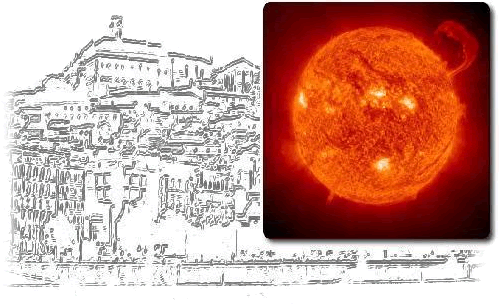|
Wave front sensing for solar telescopes is commonly implemented with Shack-Hartmann sensors. The Shack-Hartmann
lenslet sub-aperture solar image shifts/slopes are usually estimated with correlation algorithms. The sub-pixel precision image shifts are computed by applying
a peak-finding algorithm to the correlation peak (Lofdahl 2010). Usually, the measured image displacements consist of systematic errors due to pixel locking effects
(Sjodahl 1994), because correlation matching is limited only to an integer pixel grid. The amplitude of the systematic error depends on the combination of the
correlation algorithm chosen to compute the correlation peak with the type of peak-finding algorithm chosen.
To study the systematic errors in detail, solar sub-aperture synthetic images are constructed by using a Swedis Solar Telescope solar granulation image (Carlsson 2013).
The performance of different cross-correlation peak finding algorithms is investigated. The algorithms are: parabola (Poyneer 2003); quadratic polynomial (Lofdahl 2010);
threshold center of gravity (Bailey 2003); Gaussian (Nobach 2005) and Pyramid (Bailey 2003. It is found that pyramid fit is the most robust to pixel locking effects.
The RMS error analysis study reveals that threshold centre of gravity behaves better in low SNR although systematic errors in the measurement are large. It is found
that no peak finding model is good enough in attenuating both systematic errors and RMS error.
A new method is proposed to overcome the above limitations. It works in two steps. In the first, the cross-correlation is executed at the original image spatial resolution
grid (1 pixel). In the second, the cross-correlation is performed with a sub-pixel level grid and by confining the field of view to 4 x 4 pixels centered at the first step
delivered initial position. The generation of these sub-pixel grid based search windows from the spatially discrete target image is achieved with bi-linear interpolation.
This method is called as cross-correlation executed at continuous grid (CCC). This technique was previously reported in electronic speckle photography (Sjodahl 1994).
This technique is applied to wave front sensing. The combination of coarse level grid search executed in large field followed by quasi-continuous grid search executed
in a small field enables one to achieve high accuracy wave front estimation by reducing the systematic errors with a low computational cost. The results show that the
proposed method outperforms all the approaches in the first study. It improves the wave front estimation accuracy to a factor of 5 in terms of both systematic error
and RMS error (75% systematic error reduction, for 0.2 pixel sub-sampling grid), at the expense of twice the computational cost. It is also observed that the method
have very low failure rates.
The CCC method is strongly recommended for wave front sensing in solar telescopes, particularly in open loop adaptive optics, for measuring large the dynamic shifts.
Furthermore, by selecting appropriate sub-sampling in trade-off between the aimed sub-pixel image shift accuracy and the computational speed limitation, it can be
employed in closed loop adaptive optics effectively.
|



